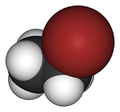Bromoethane
Bromoethane, also known as ethyl bromide, is a chemical compound with the formula C2H5Br. This organobromine compound is a colorless liquid, although older samples can appear yellowish due to decomposition. It is commonly used as a refrigerant, fumigant, and in organic synthesis as an alkylating agent. Bromoethane has a sweet ether-like odor and is volatile and flammable.
Properties[edit]
Bromoethane is a halogenated hydrocarbon with a boiling point of 38.4°C and a melting point of -119°C. It is slightly soluble in water, but highly soluble in organic solvents such as ethanol, diethyl ether, and acetone. The compound's volatility and ability to donate an ethyl group make it a valuable chemical in various organic synthesis processes.
Synthesis[edit]
Bromoethane can be synthesized through several methods. The most common method involves the reaction of ethanol with hydrobromic acid (HBr), either as a gas or dissolved in water. This reaction can be accelerated by the presence of a catalyst such as sulfuric acid:
C2H5OH + HBr → C2H5Br + H2O
Another method involves the free radical halogenation of ethane with bromine (Br2), using light or heat to initiate the reaction.
Uses[edit]
Bromoethane is primarily used in organic synthesis as an alkylating agent, introducing an ethyl group into molecules to form new chemical compounds. Its applications include the synthesis of pharmaceuticals, agrochemicals, and other organic compounds. Additionally, it has been used as a lead scavenger in antiknock fluids in gasoline, although this use has declined due to environmental concerns.
In the past, bromoethane was also used as a refrigerant and a fumigant for soil and storage facilities. However, its use in these applications has decreased due to its toxicity and the availability of safer alternatives.
Health and Safety[edit]
Exposure to bromoethane can occur through inhalation, ingestion, or skin contact. It is a potent neurotoxin and can cause respiratory distress, central nervous system depression, and kidney and liver damage with acute or chronic exposure. Safety measures include using bromoethane in well-ventilated areas, wearing protective clothing, and adhering to occupational exposure limits.
Environmental Impact[edit]
Bromoethane is a volatile organic compound (VOC) that can contribute to atmospheric pollution and the formation of ground-level ozone. It is also a potential greenhouse gas. Measures to reduce environmental exposure include controlling emissions and using less hazardous substances when possible.
Regulation[edit]
The use and handling of bromoethane are regulated under various international and national laws to protect human health and the environment. This includes regulations on air quality, chemical safety, and occupational exposure limits.
See Also[edit]
-
Bromoethane
-
Bromethan
-
Bromoethane 3D balls
-
Bromoethane 3D van der Waals
Ad. Transform your life with W8MD's Budget GLP-1 injections from $75


W8MD offers a medical weight loss program to lose weight in Philadelphia. Our physician-supervised medical weight loss provides:
- Weight loss injections in NYC (generic and brand names):
- Zepbound / Mounjaro, Wegovy / Ozempic, Saxenda
- Most insurances accepted or discounted self-pay rates. We will obtain insurance prior authorizations if needed.
- Generic GLP1 weight loss injections from $75 for the starting dose.
- Also offer prescription weight loss medications including Phentermine, Qsymia, Diethylpropion, Contrave etc.
NYC weight loss doctor appointmentsNYC weight loss doctor appointments
Start your NYC weight loss journey today at our NYC medical weight loss and Philadelphia medical weight loss clinics.
- Call 718-946-5500 to lose weight in NYC or for medical weight loss in Philadelphia 215-676-2334.
- Tags:NYC medical weight loss, Philadelphia lose weight Zepbound NYC, Budget GLP1 weight loss injections, Wegovy Philadelphia, Wegovy NYC, Philadelphia medical weight loss, Brookly weight loss and Wegovy NYC
|
WikiMD's Wellness Encyclopedia |
| Let Food Be Thy Medicine Medicine Thy Food - Hippocrates |
Medical Disclaimer: WikiMD is not a substitute for professional medical advice. The information on WikiMD is provided as an information resource only, may be incorrect, outdated or misleading, and is not to be used or relied on for any diagnostic or treatment purposes. Please consult your health care provider before making any healthcare decisions or for guidance about a specific medical condition. WikiMD expressly disclaims responsibility, and shall have no liability, for any damages, loss, injury, or liability whatsoever suffered as a result of your reliance on the information contained in this site. By visiting this site you agree to the foregoing terms and conditions, which may from time to time be changed or supplemented by WikiMD. If you do not agree to the foregoing terms and conditions, you should not enter or use this site. See full disclaimer.
Credits:Most images are courtesy of Wikimedia commons, and templates, categories Wikipedia, licensed under CC BY SA or similar.
Translate this page: - East Asian
中文,
日本,
한국어,
South Asian
हिन्दी,
தமிழ்,
తెలుగు,
Urdu,
ಕನ್ನಡ,
Southeast Asian
Indonesian,
Vietnamese,
Thai,
မြန်မာဘာသာ,
বাংলা
European
español,
Deutsch,
français,
Greek,
português do Brasil,
polski,
română,
русский,
Nederlands,
norsk,
svenska,
suomi,
Italian
Middle Eastern & African
عربى,
Turkish,
Persian,
Hebrew,
Afrikaans,
isiZulu,
Kiswahili,
Other
Bulgarian,
Hungarian,
Czech,
Swedish,
മലയാളം,
मराठी,
ਪੰਜਾਬੀ,
ગુજરાતી,
Portuguese,
Ukrainian



